 Welcome to my blog! The week of 2 July – 9 July, I’m participating with more than one hundred other bloggers in the “Freedom to Read” giveaway hop, accessed by clicking on the logo at the left. All blogs listed in this hop offer book-related giveaways, and we’re all linked, so you can easily hop from one giveaway to another. But here on my blog, I’m posting a week of Relevant History essays, each one focused on some facet of the American War of Independence. To find out how to qualify for the giveaways on my blog, read through each day’s Relevant History post below and follow the directions. Then click on the Freedom Hop logo so you can move along to another blog. Enjoy!
Welcome to my blog! The week of 2 July – 9 July, I’m participating with more than one hundred other bloggers in the “Freedom to Read” giveaway hop, accessed by clicking on the logo at the left. All blogs listed in this hop offer book-related giveaways, and we’re all linked, so you can easily hop from one giveaway to another. But here on my blog, I’m posting a week of Relevant History essays, each one focused on some facet of the American War of Independence. To find out how to qualify for the giveaways on my blog, read through each day’s Relevant History post below and follow the directions. Then click on the Freedom Hop logo so you can move along to another blog. Enjoy!
 Relevant History welcomes Lars D. H. Hedbor, a novelist of the American Revolution, focusing on the everyday experiences of ordinary people during that extraordinary era of chaotic change. The novels of his Tales From a Revolution series—The Prize, The Light, The Smoke, and now, The Declaration—examine little-known aspects of the Revolution, and are each set in a different Colony or future state. Hedbor resides in the Pacific Northwest with his wife and five daughters and enjoys practicing fiddle, homebrewing and amateur astronomy when he’s not otherwise occupied. For more information, check his web site, and look for him on Facebook and Twitter.
Relevant History welcomes Lars D. H. Hedbor, a novelist of the American Revolution, focusing on the everyday experiences of ordinary people during that extraordinary era of chaotic change. The novels of his Tales From a Revolution series—The Prize, The Light, The Smoke, and now, The Declaration—examine little-known aspects of the Revolution, and are each set in a different Colony or future state. Hedbor resides in the Pacific Northwest with his wife and five daughters and enjoys practicing fiddle, homebrewing and amateur astronomy when he’s not otherwise occupied. For more information, check his web site, and look for him on Facebook and Twitter.
*****
Most popular histories of the American Revolution focus on the events of the northern Colonies, where, indeed, many of the pivotal moments of the war and the philosophy of governance that animated the movement for independence were centered. However, the southern Colonies were also crucial to the eventual success of the war, both because it provided crucial logistical routes to move goods for both military and civilian needs despite the forced closure of ports at Boston and New York, but also because many of the leading figures of the Revolution originated in the South.
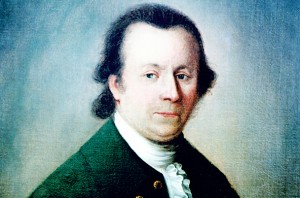 To be sure, there was greater support for the Crown in the South than in the North, in part because of the same deeply-held cultural resistance to change that characterizes the Deep South of the modern era, and in part because of the wildly different social structure of the plantations as compared to the North’s more typical smallholders. However, there was no shortage of Patriot hotheads south of the future Mason-Dixon line in the heady days leading to the outright break with England: men such as Button Gwinnett, William Polk, and Samuel Wear.
To be sure, there was greater support for the Crown in the South than in the North, in part because of the same deeply-held cultural resistance to change that characterizes the Deep South of the modern era, and in part because of the wildly different social structure of the plantations as compared to the North’s more typical smallholders. However, there was no shortage of Patriot hotheads south of the future Mason-Dixon line in the heady days leading to the outright break with England: men such as Button Gwinnett, William Polk, and Samuel Wear.
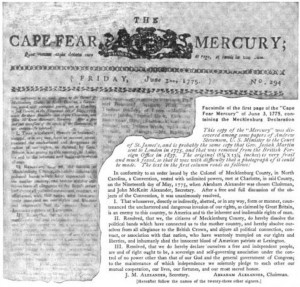 While no copy of it has been found (yet), the 20 May 1775 declaration by a gathering of delegates from militia companies around Mecklenburg County, North Carolina that they were a “free and independent people” would have anticipated the Continental Congress’ Declaration of Independence by over a full year. The existence of this earlier declaration has aroused no lack of controversy over the years, including at least one fraudulent re-creation of its supposed original publication in the Cape Fear Mercury in June of 1775.
While no copy of it has been found (yet), the 20 May 1775 declaration by a gathering of delegates from militia companies around Mecklenburg County, North Carolina that they were a “free and independent people” would have anticipated the Continental Congress’ Declaration of Independence by over a full year. The existence of this earlier declaration has aroused no lack of controversy over the years, including at least one fraudulent re-creation of its supposed original publication in the Cape Fear Mercury in June of 1775.
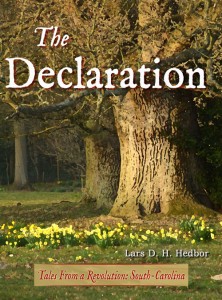 As it is, the well-documented Mecklenburg Resolves of May 31, 1775 were fully as radical as anything adopted in the northern Colonies, and the historical record is unambiguous about the vigor of various Committees of Correspondence, and later, well-armed Committees of Safety across the southern Colonies. Of course, as imagined in the pages of The Declaration, the discovery in an old family chest stashed away in the corner of some dusty attic of an authentic copy of the alleged Mecklenburg Declaration would reinvigorate the claim by proud North Carolinians of their special role in the drive toward eventual American independence.
As it is, the well-documented Mecklenburg Resolves of May 31, 1775 were fully as radical as anything adopted in the northern Colonies, and the historical record is unambiguous about the vigor of various Committees of Correspondence, and later, well-armed Committees of Safety across the southern Colonies. Of course, as imagined in the pages of The Declaration, the discovery in an old family chest stashed away in the corner of some dusty attic of an authentic copy of the alleged Mecklenburg Declaration would reinvigorate the claim by proud North Carolinians of their special role in the drive toward eventual American independence.
It may be that part of the reason that our popular memory of the Revolution omits most of the events in the southern Colonies is simply that it was there that the American cause suffered its greatest defeats. With the active assistance of Loyalist forces, the British conquered and occupied most of the southern Colonies until the waning days of the war in the north.
The occupation was ungentle, even brutal at times, and the suffering of those who had stood against the Crown has received some attention in a film of recent years, but is still largely forgotten. Forced to sign loyalty oaths, dispossessed of their property (both real estate and other), and even subjected to violence at the hands of Loyalists, those who had supported the rebellion against Britain paid a high price for their convictions.
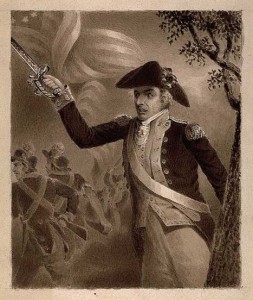 In the end, however, the rebellious Americans prevailed, and between the efforts of the well-known “Swamp Fox” General Marion and the pivotal battle at Cowpens, they ejected the British from the south, driving them northward to their ultimate defeat at Yorktown. The heroic efforts of the Patriots of the southern Colonies have long been overdue for greater recognition, and I am glad to do some small part toward that in telling the story of some of the people who made huge sacrifices and achieved stunning victories in our movement from subjects of the Crown to citizens of the Republic.
In the end, however, the rebellious Americans prevailed, and between the efforts of the well-known “Swamp Fox” General Marion and the pivotal battle at Cowpens, they ejected the British from the south, driving them northward to their ultimate defeat at Yorktown. The heroic efforts of the Patriots of the southern Colonies have long been overdue for greater recognition, and I am glad to do some small part toward that in telling the story of some of the people who made huge sacrifices and achieved stunning victories in our movement from subjects of the Crown to citizens of the Republic.
*****
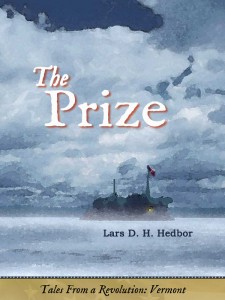
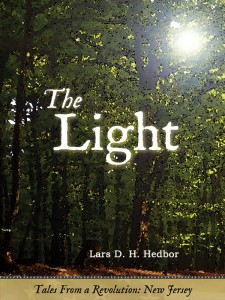
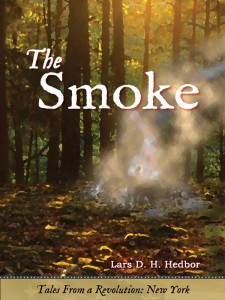 A big thanks to Lars Hedbor. He’ll give away a signed paperback set of the first three books in the series to someone who contributes a legitimate comment on this post today or tomorrow. Delivery is available within the U.S. and Canada. Make sure you include your email address. I’ll choose one winner from among those who comment on this post by Thursday 3 July at 6 p.m. ET, then publish the name of all drawing winners on my blog the week of 14 July. And anyone who comments on this post by the 3 July deadline will also be entered in a drawing to win a copy of one of my five books, the winner’s choice of title and format (trade paperback or ebook).
A big thanks to Lars Hedbor. He’ll give away a signed paperback set of the first three books in the series to someone who contributes a legitimate comment on this post today or tomorrow. Delivery is available within the U.S. and Canada. Make sure you include your email address. I’ll choose one winner from among those who comment on this post by Thursday 3 July at 6 p.m. ET, then publish the name of all drawing winners on my blog the week of 14 July. And anyone who comments on this post by the 3 July deadline will also be entered in a drawing to win a copy of one of my five books, the winner’s choice of title and format (trade paperback or ebook).
**********
Did you like what you read? Learn about downloads, discounts, and special offers from Relevant History authors and Suzanne Adair. Subscribe to Suzanne’s free newsletter.

Thank you very much for the opportunity to share my thoughts on the Revolution, and the launch of my newest novel of that time, Suzanne! I am happy to answer any questions your visitors may have, and look forward to awarding the set of books to the winner of the drawing.
It’s great to have you aboard, Lars. Congrats on the publication of The Declaration.
Love the piece. I’ve always been fascinated by the Mecklenburg Accords. Those North Carolinians were an independent bunch. The Wataugan Association (in what is now Tennessee but was then Indian Country and later North Carolina)formed in 1772 and may have been the first independent governing body in the colonies. Go North Carolina!
“Go North Carolina!” Ah, Christine, you do my heart good.
Having been a history buff since childhood and being “of a certain age”, my early education about the Revolution was limited to what happened in the north with the only mention of the Southern Campaign being a brief reference to Yorktown. From the way it was taught in school, I was led to believe that the war ended then and there, which I believed for many years. I had also thought that the south was all about the Civil War and had played only the most minor of roles during the Revolution.
After moving to South Carolina in 1985, I learned that what I’d been taught in school had been woefully inadequate to say the least. I was unaware of the Mecklenburg Declaration, but it sounds like a perfect subject for a book. Mr. Hedbor’s books sounds most interesting.
My email is included in my clickable name.
Tracy, thanks for commenting. Boy, oh boy, the view that the Revolution took place primarily in the North saturated school curricula for decades. Now they’ve gotten to the point where they mention some action in South Carolina. But they still don’t talk about North Carolina in 1781. (That’s where I step in.)
I agree whole-heartedly with what Tracy Smith said.
I look forward to reading this and Lars Hedbor’s other books!
Welcome to my blog, Jemille. I hope you’ll check in to read the essays each day through the 9th.
Thanks, Jemille – I am very eager to hear what you think of them all!
Your story line appeals to me with the finding of attic treasures. We found interesting artifacts in my parent’s attic several years ago, but nothing of historic value. I now have the letters my parents wrote back and forth when they were courting and also some that my dad wrote when he was on business trips. Wondering what all has been lost through the centuries by those not taking time to plunder the leftovers. Those dust bunnies in an attic can be like bread crumbs that are worth following.
The scenes in The Declaration that are set in the attic are almost entirely drawn from my childhood memories of the glorious attic over my grandmother’s garage. Tragically, the building burned to the ground several years ago, and all of the wealth (both financial and emotional) of material that was stored there was destroyed.
I can still remember clearly the musty smell of adventure up there, and the sense that any box I peeked into might contain some new tidbit of history and inspiration.
My grandmother’s attic also had those boxes, and we played hide-and-seek up there. It was a bit scary to me because we had to open a closet door and turn left to go up the steps to this huge room. You are right about the “smells of adventure.”
Hi Sheila! When I was a kid, there was my grandmother’s loft in a barn where she’d stored stuff. The smell of adventure was strong there, especially since some of the wood was rotting.
Well, I feel like I just fell into a treasure trove! My heart has always beat a little bit faster while reflecting upon the Revolution, all that it meant and how many brave, good people were involved in establishing this beautiful country for generations to come. As someone with family in/from North Carolina, South Carolina, and Georgia, (and one of my husband’s ancestors having fought at Cowpens), these books are going straight on my read ASAP list! Thank you for the very meaningful and wonderful post and giveaway!
Thank you very much, Susan – I look forward to hearing what you think of them! I’ll have another one out, set in the South, in the next year or so, but examining a very different aspect of the War of American Independence. Hope you enjoy all of them!
Lars,
I mix fiction with the study of Francis Marion. If you have not gotten lost in a William Gilmore Simms Rev War novel, try one on. As far as transporting one back to the time period, I think Simms is a wonderful pilot, the images, the sounds, the smells.
I will surely do so – thanks for the recommendation, David!
So glad to see the hop is back this year, Suzanne, and to learn about another series set during the Revolution! I’m looking forward to all the posts this week, even though I’ve been away from reading blogs for a while…
Lars, the Mecklenburg Resolves sounds intriguing and a wonderful basis for a novel. It’s also a particularly appropriate topic to start off the hop here. Thanks for sharing the background for The Declaration and congratulations on its publication.
After spending a few moments on your website, I must ask you, why the Revolution? You seem to have a true love for that time frame and I look forward to reading your books–this is my second favorite period in American History after the Civil War.
Linda, the American Revolution fascinates me largely because it represents a watershed moment in human history–a shift toward the idea that we are not ruled by divine consent, but lead by our own consent–and in part because there are so many untold facets of what is, on the whole, a very well-known story.
We all learn in grade school about the events in Boston, Philadelphia, and New York, but the Revolution took place across a much larger canvas, and was not at all a simple matter of the American Colonists waking up one fine morning and deciding to see what foolishness they could goad the King into.
Thank you very much for your interest, and I look forward to hearing what you think of the books, once you have had a chance to read them.
Lars, have you seen John Robertson’s map that shows the location of battles during the American Revolution? The map makes a good case for the war being a world war, not just a colonial insurrection.
I had not previously seen that map, Suzanne, though I was familiar with some of the far-flung portions of the Revoltionary War. Bookmarked now, though – thanks!!
It’s great to see you here, Linda! You’ll definitely want to stay tuned through the ninth.
Wow! What a wonderful load of information and all the books sound great! Thanks for a wonderful chance! Even if I don’t win, I’ll check the library first or be sure to buy them! Thank you!
Lynn, you rock!
Great that Lars Hedbor mentioned the “Swamp Fox” Francis Marion. SC ETV did a super video “Chasing the Swamp Fox” a few years ago but regret it did not great national distribution. Few writers mention the number of engagements in SC (more than the other colonies combined), the number of casualties in SC (more than any other colony), the number of engagements by Marion’s Brigade, or the huge effort by the British to stop this small group of militia volunteers. Perhaps some would like to join us for the Francis Marion Symposium Oct 24-25,2014. Look forward to the essays by Christine Swager, David Neilan and Jack Parker. This is a wonderful program!
Thanks for stopping by, George. You’ll see more here of Francis Marion before 9 July, I promise.
I would love to read these books! I have always LOVED American history (pre-1900). I grew up watching the Swamp Fox on tv, which is what first got me into looking into the history of the Swamp Fox. I love that more historical fiction is being written about this time period in America. Thank you Mr. Hedbor and Ms. Adair for this great give away and for being authors.
Thanks for visiting my blog, Deb. I also watched Disney’s “Swamp Fox” when I was a kid. Not too accurate — what coming out of Hollywood about the American Revolution is accurate? — but I’m sure the show got a bunch of kids (and adults) curious about the time and events.
Liberty Kids was a great cartoon series set in Philly. This is one of the things that got my son (who is now 22) into this time period. So much so, he became friends with Lora Innes, who does THE DREAMER graphic novels. While it takes place in a modern high school, the main teenage girl dreams about the Revolution. A lot of people have been introduced to Joseph Warren and Nathan Hale. The historic parts are accurate. I love the fact that it seems that the Revolution is being written about more and more!
Deb, I’ve been following The Dreamer all along. Ever since “the kiss.”
Lora is a hoot, isn’t she? I had the honor of reviewing The Dreamer and interviewing her for the Journal of the American Revolution last year: http://allthingsliberty.com/2013/04/dreaming-of-revolution/
Lora is a great person. My son, Sean, is actually her personal assistant now. Through her, Sean has become friends with Dr. Sam Forman also.
I am looking forward to buying your books and reading them.
I remember Disney’s Swamp Fox. A few years ago after reading a couple biographies of Francis Marion, I obtained a DVD with 6 episodes. Wow: talk about convoluted scenes. Despite the shuffling of actions, it was still great. And Leslie Nielsen as Francis Marion. And that poor alligator swimming around those California ‘swamps.’ In the TV show it looked like he–Marion, not the alligator–was 25 or so. In real life he would have been 48. And that babe Marion was sweet on, in real life his cousin Mary Esther Videau. He did marry her finally, when he was 54.
David, you realize, don’t you, that Mary Esther Videau was the only woman who would marry him — and at that, she had to have her arm twisted.
We lived in Timmonsville, S.C. which is near Florence, and learned about the `Swamp Fox`. We also visited the observatory at Francis Marion University, named after the Swamp Fox.
Thank you for this post. My family would enjoy these books.
Michelle, thanks for commenting. Have you ever been to the Camden living history/reenactment event the first weekend in November?
Your suggestion that the lack of ‘coverage’ of the Southern Campaign was partially due to the Americans suffering its greatest defeats in the South is an interesting hypothesis. I always believed it was due to Northern historians. I am reading a little book by South Carolina’s William Gilmore Simms–South Carolina in the Revolutionary War(1853). Simms lambasts mid-19th century historians, headed by Lorenzo Sabine, for their inaccurate treatment of the South, specifically South Carolina. The first 50 pages are scorchers.
David, I suspect it’s a combination of both.
It is also likely due to the greater concentration of population in the North, then and later. We also don’t hear about events in the frontier regions of the Northern Colonies, yet some of those were no less pivotal.
Fortunately, this gives us, as novelists of the Revolution, lots of choices when looking for lesser-known stories of the era.
Lars,
For good stories check out Weems’s biography of Marion that was originally attributed to Peter Horry. Weems is the same guy who wrote Washington’s bio and–don’t quote me here–the wonderful cutting down the cherry tree and throwing the coin or stone across the Potomac. His Marion stories are not so colorful, but the embellishments saturate the book. In my opinion Weems was the original publisher of Marion’s sobriquet “swamp fox,” not William James, who (mis-)quoted Tarleton in his 1821 bio, “Come, my boys! let us go back. We will soon find the Game Cock (meaning Sumter), but as for this d—d Swamp-fox, the devil himself could not catch him.” Weems’s fiction pre-dated James. I can’t imagine Weems–or anyone else, for that matter–passing up such a dramatic quote. Ever since Weems and James, Marion’s biographers have continued to walk a tightrope in using or not using the flowery imagery of the original writers. Unfortunately, it makes it impossible to write the ‘true’ story about Marion. On the other hand, without Weems and James romanticism, the Marion saga might never have passed beyond the borders of South Carolina. There would not have been a Disney “Swamp Fox” or a Mel Gibson “Patriot.”
I love reading about the Revolutionary War especially since I discovered an ancestor who fought in it. It makes it more real to me.
Welcome, Madonna. Where did your ancestor fight in the war?